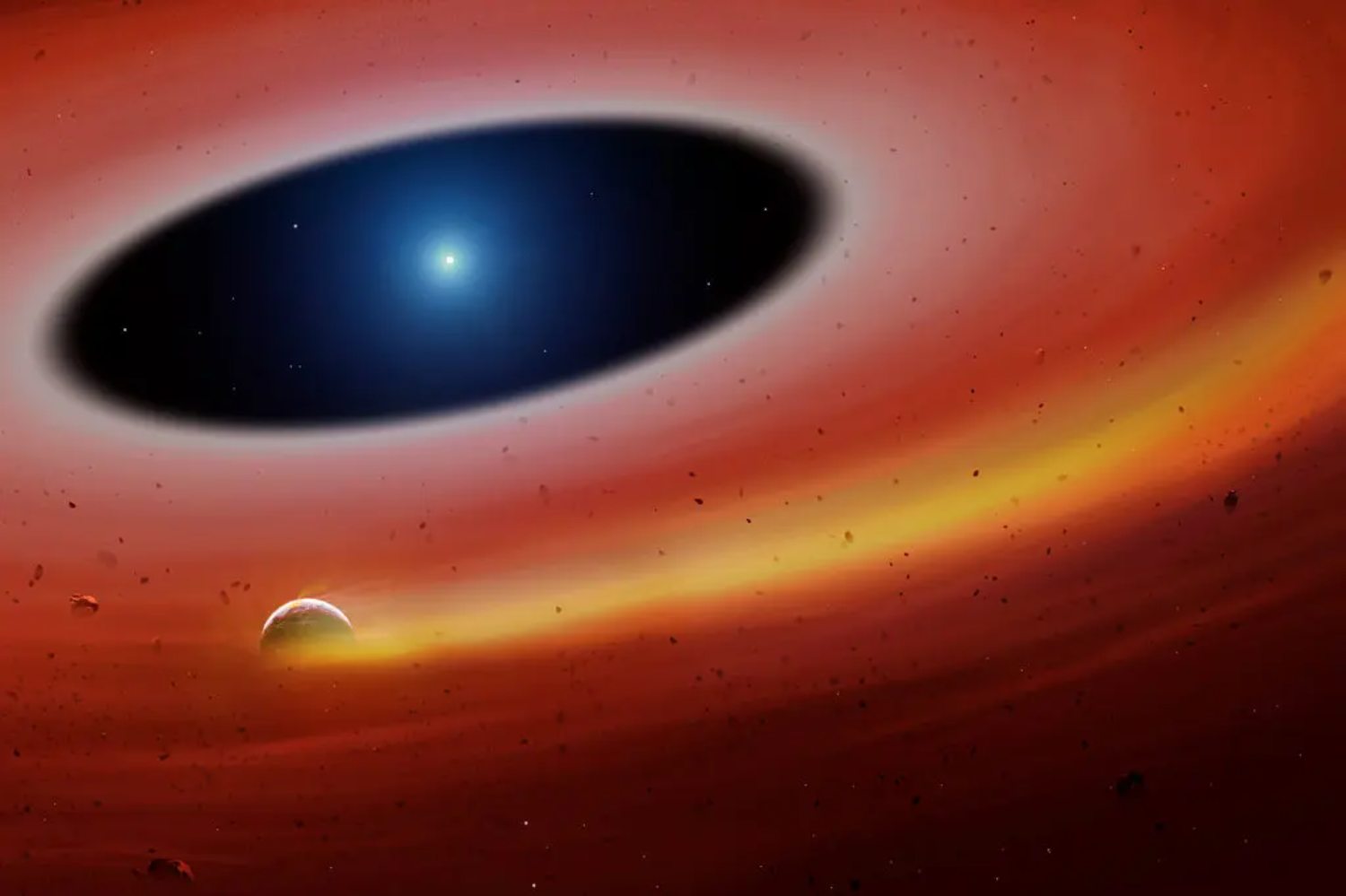All stars begin their lives in a dense area of a Nebula, which eventually collapses in on itself, condensing into a massive globule of gas and dust. As the stuff cools and condenses, it generates heat and light, giving rise to the first stars, known as Protostars. Protostars consume a great deal of gas from the surrounding circumstellar disk in order to grow into mature stars. However, it is not so simple, since their stellar wind drives away this source of material. Until recently, astronomers didn’t know how stellar embryos keep expanding.
Whether it’s the Sun, a red dwarf, or a big star, all stars start out as clumps of gas and dust. After their “raw material” collapses locally, they continue to expand within that region until they are large enough to spark hydrogen fusion. Although seemingly straightforward, the reality is fraught with complexity and difficulty. The final phase of star formation was questioned for a long time.
The process of star birth
The Sun, like all stars, was born in a cloud of very cold molecular gases. However, it takes time and a few developmental stages for a new budding star to emerge from such a stellar nursery and blaze forth. The nature of this star formation is still unclear.
The final phase of star formation was questioned for a long time.
New star formation is often triggered by gravitational turbulence in a dense molecular cloud, such as the compression of gas flows or the shock waves of a nearby supernova. A similar stellar explosion likely triggered the formation of our Sun. Evidence of this supernova has been found in the isotopic data of meteorites from the early days of our solar system. Furthermore, the majority of star nurseries in the neighborhood are located at the boundary of a massive bubble liberated by supernova shock waves.
Due to the shocks, the molecular cloud collapses in some regions, with the gas collapsing under the weight of its own gravity and becoming very dense. A prestellar core, a cluster of compressed molecular hydrogen gas, is formed in the zone’s center as a result. In a star like our Sun, this prestellar core can become so enormous that it swallows up the inner solar system.
From the prestellar core to the protostar

This initial prestellar core is rather cool by astronomical standards. At first, the temperature is just a little over 390°F (200°C). However, when additional matter from the periphery continues to reach the core, the central region gradually expands, increasing in temperature and density. After this stellar embryo reaches a temperature of about 3100°F (1,700°C), the hydrogen present as a diatomic molecule in the prestellar clump decays to hydrogen atoms as a result of the intense pressure and temperature.
The heat that was being produced is now being dissipated into atoms and molecules of water. In consequence, the prestellar core is unable to maintain its strength in the face of its growing mass, and the dense, hot clump once again collapses under its own weight. The central region of the prestellar disk is now a protostar.
Already, the protostar is much more compact than its predecessor. Around 1.5 times smaller than it is now, our Sun might have reached temperatures of several thousand degrees on its interior at this time. Nonetheless, the early conditions of such a protostar are not conducive to the ignition of hydrogen fusion. The young protostar only has about 1% of its ultimate mass, so it must continue to grow in order to reach maturity. Although the protostar is already glowing, much of the energy it needs to do so comes from the matter that keeps falling over it.
Those burping T Tauri stars
T Tauri stars, named after the first protostar of its sort in the constellation Taurus, are among the protostars in this development phase. These stars are still in their embryonic stages, perhaps about a million years old. Continuous accretion lessened the gas and dust envelope around them, but they are still encircled by the cloud’s leftovers.
These protostars amass their inhaled material in a flat, spinning disk around their equators. The circumstellar disk provides the “food reservoir” for the developing star and the raw material for planet formation in the distant future. As the protostar accretes more and more material from the disk, it often “burps,” or unexpectedly expels greater spurts of gas and radiation because of the high radiation and turbulence during accretion.
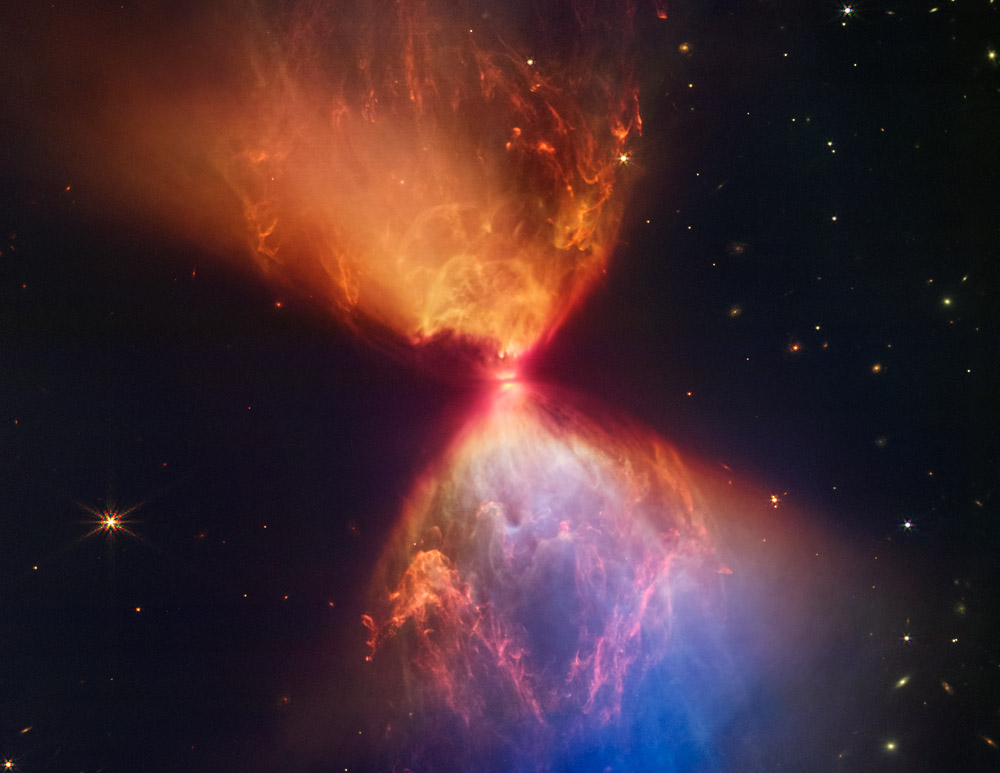
Material “belched” in this way generates gaseous cones and bright shock fronts that extend into deep space. The T Tauri star L1527 IRS and its ejected debris are shown in this magnificent new picture acquired by NASA’s James Webb Space Telescope. The protostar, the expelled gases, and the circumstellar disk are all clearly visible in the near-infrared picture. At its current rate of growth, L1527 IRS might eventually weigh as much and be as massive as the Sun.
However, astronomers have long been perplexed by the development of T Tauri stars.
L1527, a typical T Tauri star, is shown above by the James Webb Telescope. The protostar is the bright spot in the middle of a revolving disk of material. Conspicuous cones of shocked gas have formed on each side of the protostar as a result of its repeated eruptions.
How do you feed a baby protostar?

At first look, the process by which a newborn protostar draws gas and dust to fuel its eventual growth into a star seems straightforward. After all, as its mass increases, its gravity should pull the required “food” from the clouds in the vicinity.
This, however, is incorrect. The material that is pulled in by the star embryo does not fall in a straight line onto the protostar, but rather is propelled into a circular orbit around the star. The gas and dust masses collected by the protostar create a revolving accretion disk due to the placement of the shared center of mass and the conservation of angular momentum. Material near the disk’s inner edge rapidly loses energy, slows down, and crashes into the protostar along a curved path due to friction processes in the disk.
The issue is that the protostar’s expanding radiation overwhelms this accretion. It clears out a space between the rotating matter disk and the stellar surface, which can be several stellar radii in width, and thus poses a threat to the star’s growing embryo by severing its fuel supply.
TW Hydrae
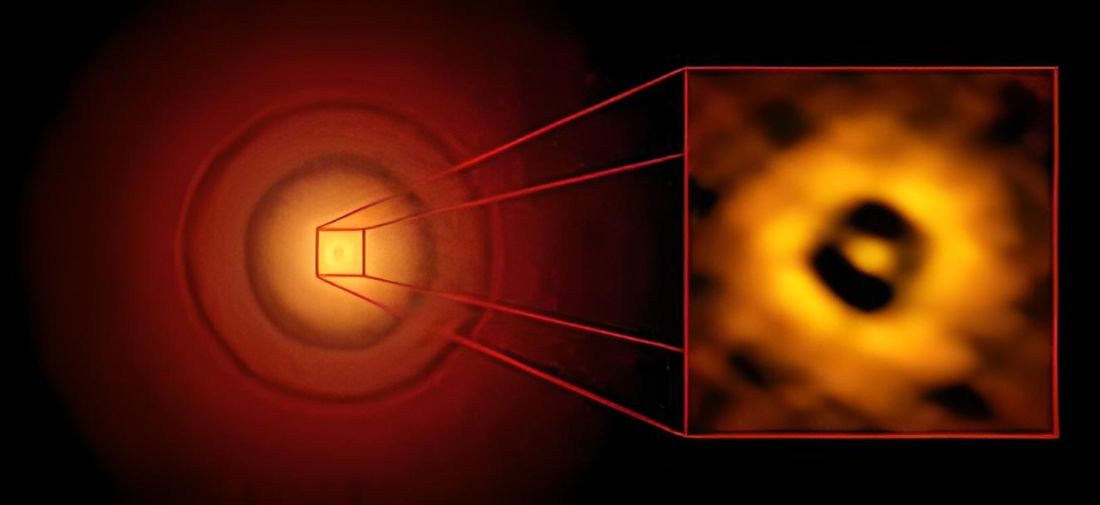
This is especially clear in the instance of the T Tauri star TW Hydrae, which is just around 180 light-years distant. This eight-million-year-old protostar presents the face of its circumstellar disk to us, allowing us to see its structure clearly. Because of this, it can be used as a stellar object to investigate the transport of material from a planetary-formation disk to the surface of a star.
As a result, scientists have been carefully monitoring this T Tauri star with radio telescopes and the Hubble Space Telescope for quite some time. Images demonstrate, among other things, a substantial separation between the disk’s inner edge and the star. TW Hydrae is a protostar with a “transition disk,” as shown by its inner hole and little infrared excess.
So the spinning “food supply” of this protostar is already being dissolved by the powerful stellar wind and the planets developing in the circumstellar disk. Therefore, it is quite unlikely that TW Hydrae would expand, since it no longer has access to the necessary nutrients. The stellar wind should have removed almost all of the gas from the inner disk. But interestingly enough, this doesn’t appear to bother the protostar at all; it keeps expanding, and measurements show that it’s still consuming approximately 2.3 billionths of a solar mass every year, which is a lot for a protostar its age.
Currents that have been redirected
The question is, where does TW Hydrae acquire its “food?” The radiation emitted by the protostar and its disk was studied more closely, and the results showed that material is being sucked in from the disk’s inner edge and onto the star’s surface. The circumstellar disk is located on the equatorial plane, however, these gases do not travel there. Instead, the material is deflected toward the star’s poles, where it eventually falls to the stellar surface.
This prompts the issue of the material’s motivations and the factors that drive its detour: How is it that this “stellar food” manages to make it to the protostar despite the strong winds?
Magnetic fields stimulate protostar growth
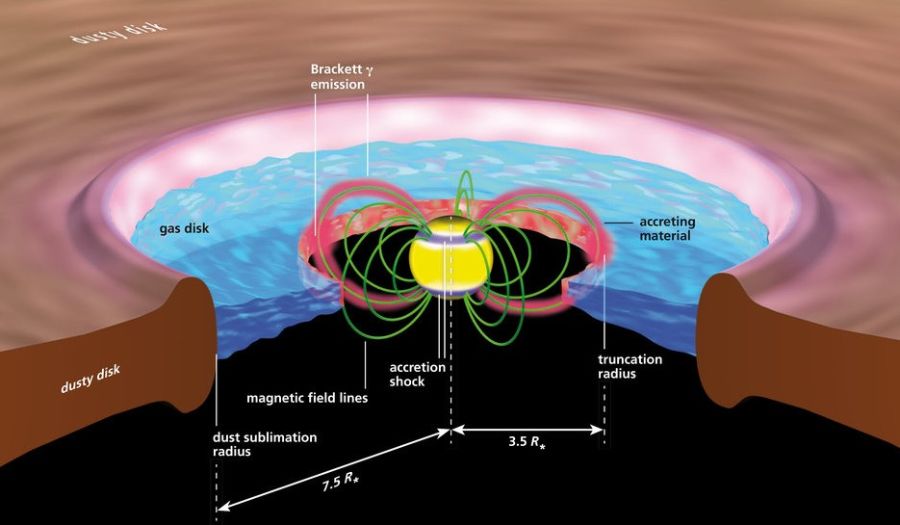
The Milky Way’s stellar nurseries are living proof that stars may and do overcome the last obstacle in their development, amassing enough mass to spark hydrogen fusion in their cores and emerging as brilliant newborn stars. To achieve this goal, they must overcome headwinds, rotation, and large gaps in the matter disk in order to draw in the surrounding “accretion.” Because of this, accretion during the T Tauri period is very challenging.
Already in the 1990s, astronomers theorized what components might aid the protostars in this process. They posited that magnetic fields are common among stars. This factor significantly contributes to sunspots, solar eruptions, and solar storms on our star. Solar plasma and the solar corona are influenced by the orientation of its magnetic field lines. The field lines can extend much beyond the solar surface, guiding the solar plasma like invisible tubes.
Therefore, it was clear to scientists that even developing protostars contain a magnetic field. This star’s magnetic field likely has field lines that go out to the inner border of the circumstellar disk, the revolving material supply for the stellar embryo. As with solar plasma, gas from the protostar’s disk might move along these magnetic field lines to the poles.
High-velocity gases and intense fields
This would explain how T Tauri stars are able to overcome the resistance of their own stellar wind and the angular momentum of the revolving material. Yet the paradigm of the 1990s was at first merely a theoretical construct. This was because, even at close protostars, telescopes lacked the resolution to clearly reveal the processes. It was thus still unknown whether or not the field lines of the stellar magnetic field coincide with the route taken by the material drawn to the protostar.
Between then and now, astronomers have shown that certain types of protostars do, in fact, contain a magnetic field. The flux density from this may approach a thousand Gauss. The magnetic field of Earth is just approximately 0.5 gauss. Astrophysical models and high-resolution spectra both point to rapid acceleration and intense heating of material moving from the accretion disk to the T Tauri star.
Observations of several T Tauri stars show that they emit much more X-ray and ultraviolet (UV) energy between the main surface and the circumstellar disk. The simulations suggest that it might originate in the incoming gas to the protostar. In the simulations, this radiation is the result of the material decelerating so rapidly near the star’s surface. Some of it is lost to space, while the remainder should flow toward the star’s surface, creating a hot zone.
What we have are some hypotheses and some preliminary, indirect evidence. Yet, is there any way to demonstrate this without indirect evidence?
How T Tauri stars get their supplies
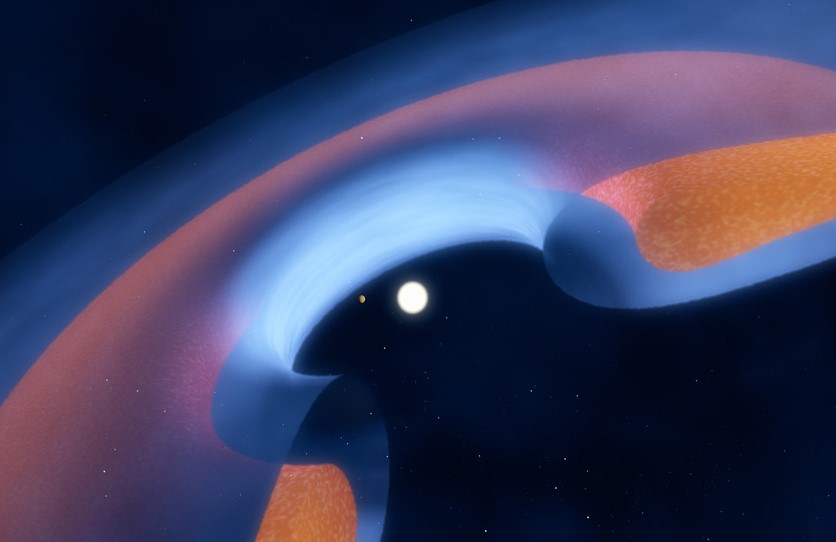
However, astronomers have made two significant discoveries in the meantime. Using state-of-the-art telescope equipment, scientists were able to provide conclusive evidence for two protostars that magnetic fields play a critical role in the “feeding” of stellar embryos. This confirms the notion proposed by astronomers a few decades ago.
The GRAVITY instrument at the European Southern Observatory (ESO) in Chile facilitated the collection of this evidence. An interferometer was installed in 2016 to integrate data from the Very Large Telescope’s (VLT) four 26-foot (8-meter) mirrors on Paranal. This yields photos with the same sharpness as a 330-foot (100-meter) telescope.
Eating
In 2020, astronomers headed by University of Grenoble professor Jérome Bouvier achieved the first major breakthrough. The GRAVITY probe was used to investigate the young protostar DoAr 44. Located in the Rho-Ophiuchus star-forming area, 476 light-years away, this is now in the T Tauri phase of its evolution. Around 30 AU separate it from the material disk’s inner border.
As a result, this protostar is now at the stage when it faces increasing difficulty in the accreting matter by its gravitational attraction alone. Despite this, the GRAVITY data showed that DoAr 44 is able to pull gas from its circumstellar disk. Spectral studies have shown that the hydrogen gas toward the inner edge of the accretion disk is initially ionized by the protostar’s intense UV radiation. As a result, the stellar magnetic field can exert its impact on the ionized plasma of protons and electrons.
A very bright glowing zone was also seen by Bouvier and his team close to the protostar’s surface. The spectral analysis confirmed the models’ predictions that the radiation came from hot, rapid gas between the star’s surface and the disk. This radiation likely originates in magnetic flow channels between the inner border of the disk and the stellar surface, as shown by its large size and modest offset with regard to the central star.
Magnetic field
Later, scientists produced the second crucial discovery (Nature). In this case, they aimed the GRAVITY telescope towards the famous T Tauri star TW Hydrae. Radiation of hot, ionized hydrogen was found from this protostar as well; like the radiation from the disk of matter and the surface of the star, this radiation originated in the space between the two.
Scientists observed the transport of debris from the disk encircling the star. As a result, they became the first scientists to discover the mechanism by which stars are produced, and, by extension, planets. It has been seen that the ionized hydrogen gas moves in thin columns from the disk to the star, following magnetic field lines. It seems that the hypothesis of accretion in the magnetosphere is correct.
Further research
This solves a longstanding mystery concerning the formation of protostars. But there are still a lot of questions unanswered. One of them is a better understanding of the physics of magnetospheric accretion and how it occurs close to the surface of stars. It is also not entirely obvious how the protostellar magnetic field is structured. According to scientists, the magnetic fields may be far more intricate and contain extra poles.
This should become clearer when further investigations of T Tauri stars with the GRAVITY instrument are conducted. “These include observations that track how the impact point of the gas on the stellar surface shifts over time,” explains Henning’s colleague Wolfgang Brandner. This may help scientists determine how far the star’s magnetic poles have moved with respect to the star’s rotation axis.
This might also shed light on whether or not magnetic fields in protostars evolve and how they are connected to T Tauri stars’ recurrent outbursts. Thus, even if some of the riddles of developing young stars have been answered, astronomers still have a long way to go.




